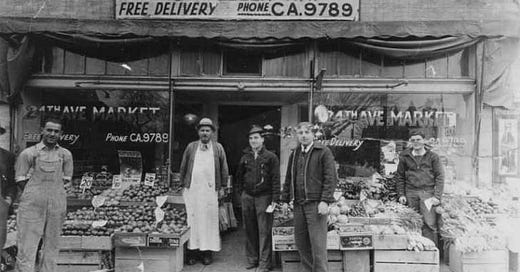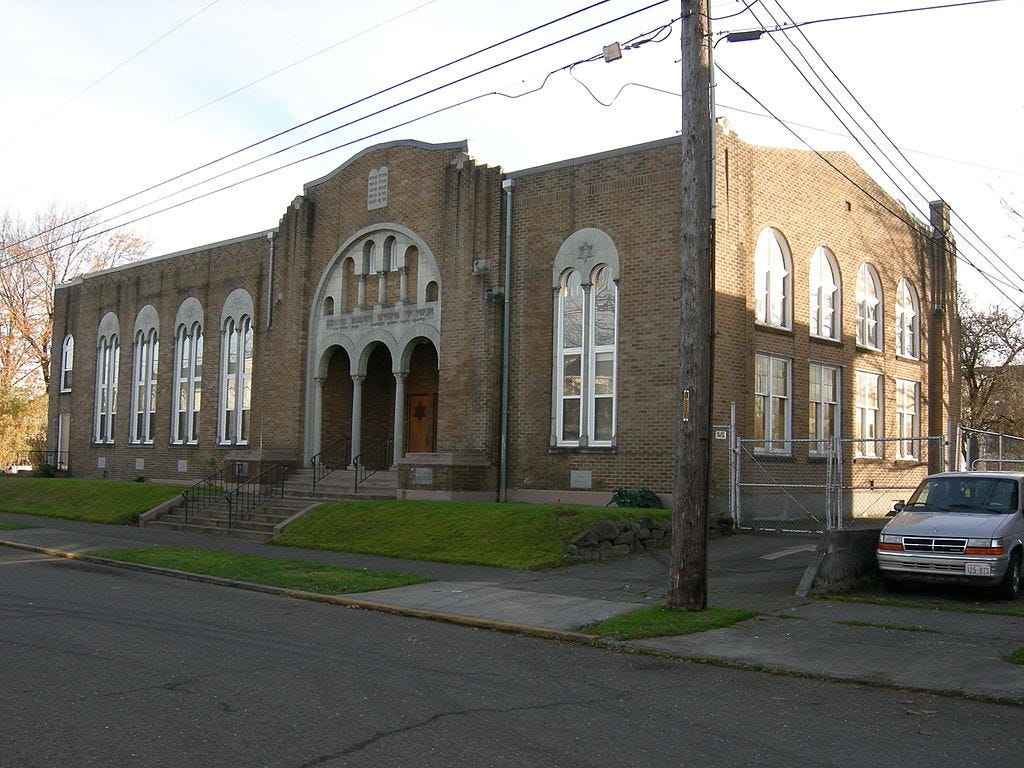Seattle's Lost Jewish Utopia
A new tour of the Central District stirs emotions about a bygone era of local Jewish life — and establishes new points of connection with the CD's Black community.
Jumping right in today, but first, a few updates on past Cholent posts. Thanks to everyone who had nice things to say about my reflection on Israel-Gaza. I hate when people say this, but…we are in this together.
Check out Nissim Black on Tablet’s Unorthodox podcast — better yet, check out his own podcast, The Deal with Nissim Black. I just listened to his interview with Eve Barlow and it is SO GOOD. If you’ve been grappling with race, Zionism, anti-Semitism, and identity (and you have, because it’s 2021 and you are a human), I recommend listening.
Also check out Loolwa Khazoom’s album, which drops today! It’s also REALLY GOOD.
Keeping it short…enjoy this week’s read.
—Emily
A Walk Down Memory Lane
The new Washington State Jewish Historical Society tour of Sephardic life in the Central District is an exercise in nostalgia — and relationship building.
Stuart Eskenazi had been going to Broadcast Coffee, on the corner of Yesler and 20th in Seattle’s Central District, for years, when one day he parked a block north and looked up. Before him stood the Tolliver Temple Church of God in Christ. But he noticed something for the first time: big Stars of David on the doors and facade. He realized he was standing in front of the old Sephardic Bikur Holim, his family’s synagogue and the place his parents were married.
The Central District is a living palimpsest; look closely and you’ll see different community stories under the surface of the streets and buildings. This is what the Washington State Jewish Historical Society is trying to show in its latest program, a virtual Central District tour of Sephardic life.
“I do actually think it’s the most special thing I’ve done,” says WSJHS executive director Lisa Kranseler. Kranseler is entering her 15th year in the role, and she’s pulled off more than a few big projects. The Central District, where Seattle Jewish life blossomed in the first half of the 20th century with immigrants from former Ottoman Turkey and Rhodes as well as Europe, is not new material. But the presentation — a virtual tour with photos and snippets of oral histories from the Jewish Archives at the University of Washington as well as videos of Sephardic community elders who fondly remember their old neighborhood — is the culmination of years of research, collaboration, and collection.
“It’s the Sephardic community, but it’s everyone,” Kranseler says. “I heard about all these things for years but living and breathing and seeing these images made it come to life.”
For the tour’s volunteer curators and contributors — including members of the Seattle Sephardic Network — this nostalgic element is what sets the tour apart. Jewish life in the Central District is well documented, but the memory is fading. What was once a concentrated neighborhood bustling with kosher markets, candy shops, synagogues, and schools — where everyone knew everyone and children could walk into any home — fizzled out in the late 1950s, early 1960s, when Jewish families fanned out north, south, and east. With the Central District’s children now seniors, and perhaps because of a cultural desire to return to community and simpler times, the tour is as much about tapping into an emotion as it is about conveying information.
“It’s really more of a celebration of history. It could be an academic exercise, but it’s not,” says Eskenazi. “I used to hear the stories from my dad who grew up in the Central District — the closeness of the community and how everybody knew everybody. It was a Jewish community that I had a hard time picturing.”

Sue Solomon, another WSJHS volunteer, shares a similar sentiment. “The tour is exciting to think about how different their lives were from ours, not just in Seattle, but in the world. But in Seattle, the Sephardic community was all together, they spent Shabbat together. For most of us, there’s not that feeling of growing up in a large community and knowing that you’re related to them all and you have a shared history.”
Not only is the Jewish Central District story fading among our own community, it’s virtually invisible to everyone else. “With the gentrification that’s going on in the Central District, there are people maybe going there for the first time or maybe living there now, and they don’t understand the history,” says Eskenazi. “It’s a multifaceted history.”
The CD has been home to the Black community for over half a century now, and that community struggles to hold in the center of the booming city. In the process of creating the tour, WSJHS forged a relationship with the Black Heritage Society of Washington State, which had developed its own tour.
Stephanie Johnson-Toliver (no relation to the “two-L Tollivers”), president of the Black Heritage Society, marvels at the points of connection. She shares the desire to pass this down to younger generations. And even she was taken aback by the depth of the Jewish community experience here. “All of these wonderful connections are coming out of it, it’s almost creepy,” she says. “My grandmother’s sister lived two houses from the Eskenazis in the Central District. I was looking at the census, and I noticed that two neighbors down was the Eskenazi family. I was like, oh my God, what?”
She and Kranseler are excited about working together in the future, and already they have supported each others’ organizations. The Jewish historical society wrote a letter of endorsement to get the Tolliver Temple on the historic registry; Toliver imagines collaboration on the tours in the future.
“It’s so fascinating that several of the stops are the same,” says WSJHS and Seattle Sephardic Network volunteer Cynthia Flash Hemphill. “The library: the Jews knew it as the Yesler Library. Now it’s called the Douglass Truth Library. The [Ashkenazi] Bikur Cholim is now the Langston Hughes [Performing Arts Center]. The former Sephardic Bikur Holim is now Tolliver Temple, a Black church. If you look at these buildings, you can see the evolution. There’s Jewish iconography on these buildings. Especially during these times, when we’re all learning more about our country’s history with racism, it’s important to embrace the multiple cultures that did inhabit the same space.”

“These were African Americans, Jewish families, Danish families, Chinese and Japanese families that really created the vitality in the Central District early on, in the early 1900s forward,” Toliver says. “To be able to share these tours, to bring everybody to date to know this really rich history, it’s wonderful.”
No tour can reconstitute the sense of community that pulsated through the CD as various groups established themselves there before moving on or having to move out. But the WSJHS virtual tour is a step toward preserving a feeling of community that was lost as Jews embraced the American Dream of moving to the suburbs and either assimilating into mainstream society or establishing new neighborhoods in the south and north ends.
“I knew very little about the Jewish presence in the Central District before diving into this,” says Hemphill. “My dad would tour me around, and we would stop in certain places and read and learn about it. When I would talk to the seniors, it was a little like touring Rhodes: My ancestors walked these streets. I kind of felt the same walking these Seattle streets. It kind of hit me. I never expected to feel so nostalgic.”
Community Announcements
Check out the Seattle Jewish community calendar.
This week’s parasha is Shelach. A team of Israelites scouts out the land of Israel and finds giants living there. They perceive themselves as looking “like grasshoppers in their eyes” and try to sabotage their own divine destiny. As punishment, they have to wait out another two generations as wanderers.
Candlelighting in Seattle is at 8:44 p.m.
Shoutouts!
Mazal Tov Maayan and the Seattle Hebrew Academy Eagles on your preschool graduation. —Mom and Dad, Sonya and Etan Basseri
Happy birthday Janet Jassen, the best mom and our favorite Noni! —Sonya, Etan, Ezra, Maayan, and Shai Basseri
To the Seattle Sephardic Network and the Seattle Sephardic Community in general: Thanks for all the stories, memories, photos and sharing you all did to help create an incredible Sephardic Tour Release — I look forward to seeing y’all out there in the old neighborhood celebrating history. Hugs to all, Lisa Kranseler, ED WSJHS
In my call for shoutouts this week, I threw out a call for Dad jokes. And I got one:
When does a joke become a “dad joke”?
A: When it becomes apparent.
Thanks, David Sabban!





